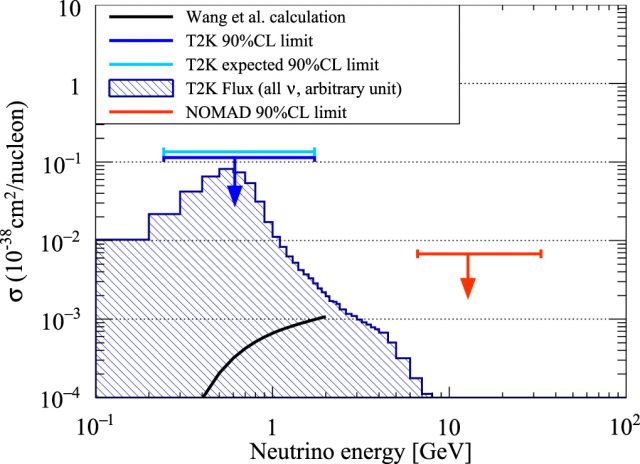Simultaneous measurement of the muon neutrino charged-current cross section on oxygen and carbon without pions in the final state at T2K
This paper reports the first simultaneous measurement of the double differential muon neutrinocharged-current cross section on oxygen and carbon without pions in the final state as a function ofthe outgoing muon kinematics, made at the ND280 off-axis near detector of the T2K experiment. The ratio of the oxygen and carbon cross sections is also provided to help validate various models’ability to extrapolate between carbon and oxygen nuclear targets, as is required in T2K oscillationanalyses. The data are taken using a neutrino beam with an energy spectrum peaked at 0.6 GeV.The extracted measurement is compared with the prediction from different Monte Carlo neutrino-nucleus interaction event generators, showing particular model separation for very forward-goingmuons. Overall, of the models tested, the result is best described using Local Fermi Gas descriptionsof the nuclear ground state with RPA suppression.
T2K measurements of muon neutrino and antineutrino disappearance using 3.13E21 protons on target
We report measurements by the T2K experiment of the parameters θ23 and Δm322, which govern the disappearance of muon neutrinos and antineutrinos in the three-flavor PMNS neutrino oscillation model at T2K’s neutrino energy and propagation distance. Utilizing the ability of the experiment to run with either a mainly neutrino or a mainly antineutrino beam, muon-like events from each beam mode are used to measure these parameters separately for neutrino and antineutrino oscillations. Data taken from 1.49×1021 protons on target (POT) in neutrino mode and 1.64×1021 POT in antineutrino mode are used. The best-fit values obtained by T2K were sin2(θ23)=0.51-0.07+0.06(0.43-0.05+0.21) and Δm322=2.47-0.09+0.08(2.50-0.13+0.18)×10-3 eV2/c4 for neutrinos (antineutrinos). No significant differences between the values of the parameters describing the disappearance of muon neutrinos and antineutrinos were observed. An analysis using an effective two-flavor neutrino oscillation model where the sine of the mixing angle is allowed to take nonphysical values larger than 1 is also performed to check the consistency of our data with the three-flavor model. Our data were found to be consistent with a physical value for the mixing angle.
First Measurement of the Charged Current antinumu Double Differential Cross Section on a Water Target without Pions in the final state
This paper reports the first differential measurement of the charged-current muon-antineutrino interaction cross section on water with no pions in the final state. The unfolded flux-averaged measurement using the T2K off-axis near detector is given in double-differential bins of μ+ momentum and angle. The integrated cross section in a restricted phase space is σ=(1.11±0.18)×10E−38 cm2 per water molecule. Comparisons with several nuclear models are also presented.
Constraint on the matter–antimatter symmetry-violating phase in neutrino oscillations
The charge-conjugation and parity-reversal (CP) symmetry of fundamental particles is a symmetry between matter and antimatter. Violation of this CP symmetry was first observed in 19641, and CP violation in the weak interactions of quarks was soon established2. Sakharov proposed3 that CP violation is necessary to explain the observed imbalance of matter and antimatter abundance in the Universe. However, CP violation in quarks is too small to support this explanation. So far, CP violation has not been observed in non-quark elementary particle systems. It has been shown that CP violation in leptons could generate the matter–antimatter disparity through a process called leptogenesis4. Leptonic mixing, which appears in the standard model’s charged current interactions5,6, provides a potential source of CP violation through a complex phase δCP, which is required by some theoretical models of leptogenesis7,8,9. This CP violation can be measured in muon neutrino to electron neutrino oscillations and the corresponding antineutrino oscillations, which are experimentally accessible using accelerator-produced beams as established by the Tokai-to-Kamioka (T2K) and NOvA experiments10,11. Until now, the value of δCPhas not been substantially constrained by neutrino oscillation experiments. Here we report a measurement using long-baseline neutrino and antineutrino oscillations observed by the T2K experiment that shows a large increase in the neutrino oscillation probability, excluding values of δCP that result in a large increase in the observed antineutrino oscillation probability at three standard deviations (3σ). The 3σ confidence interval for δCP, which is cyclic and repeats every 2π, is [−3.41, −0.03] for the so-called normal mass ordering and [−2.54, −0.32] for the inverted mass ordering. Our results indicate CP violation in leptons and our method enables sensitive searches for matter–antimatter asymmetry in neutrino oscillations using accelerator-produced neutrino beams. Future measurements with larger datasets will test whether leptonic CP violation is larger than the CP violation in quarks.
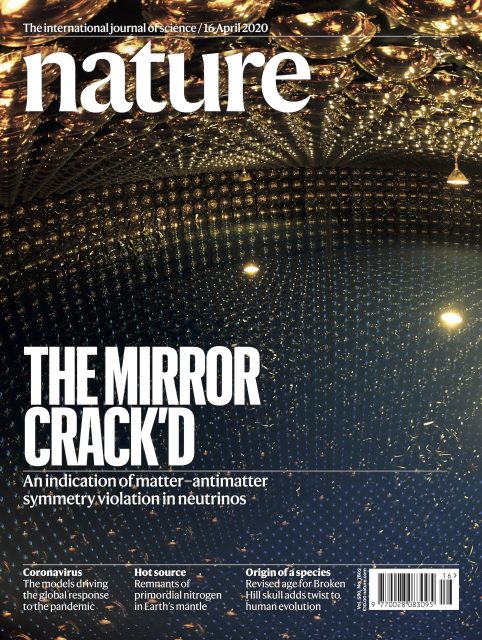
Measurement of the charged-current electron (anti-)neutrino inclusive cross-sections at the T2K off-axis near detector ND280
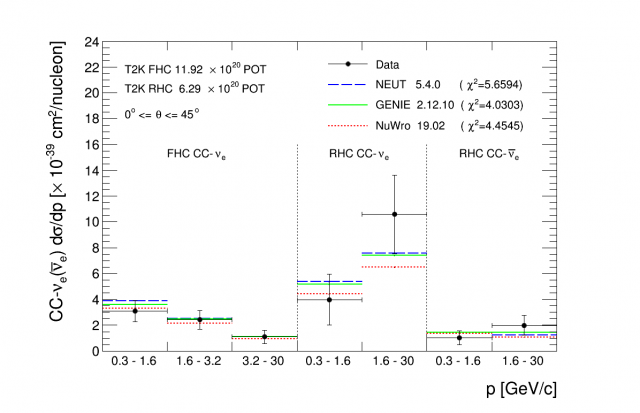
First combined measurement of the muon neutrino and antineutrino charged-current cross section without pions in the final state at T2K
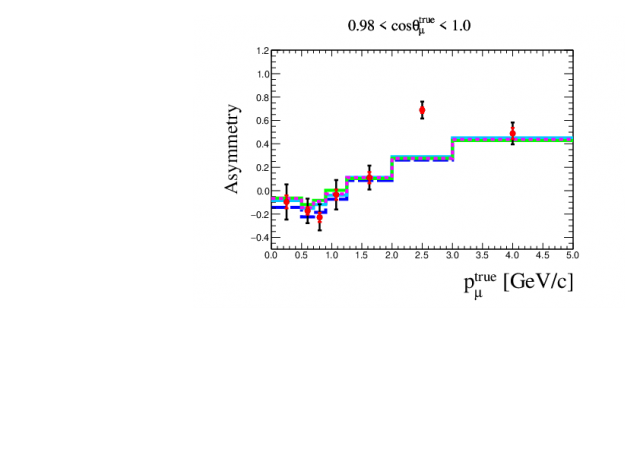
Measurement of the muon neutrino charged-current single $\pi^+$ production on hydrocarbon using the T2K off-axis near detector ND280

Measurement of neutrino- and antineutrino-oxygen neutral-current quasielastic-like interaction cross sections by detecting nuclear de-excitation gamma-rays at the far detector with Run1-9 FHC and RHC data
Neutrino- and antineutrino-oxygen neutral-current quasielasticlike interactions are measured at Super- Kamiokande using nuclear deexcitation γ rays to identify signal-like interactions in data from a 14.94(16.35) × 10^20 protons-on-target exposure of the T2K neutrino (antineutrino) beam. The measured flux-averaged cross sections on oxygen nuclei are 1.70 +- 0.17(stat)+-0.51(syst) × 10^-38 cm2/oxygen with a flux flux-averaged energy of 0.68 GeV, for neutrinos and antineutrinos, respectively. These results are the most precise to date, and the antineutrino result is the first cross section measurement of this channel. They are compared with various theoretical predictions. The impact on evaluation of backgrounds to searches for supernova relic neutrinos at present and future water Cherenkov detectors is also discussed.
Published in Phys.Rev. D100 (2019) no.11, 112009
DOI: 10.1103/PhysRevD.100.112009
e-Print: arXiv:1910.09439 [hep-ex]
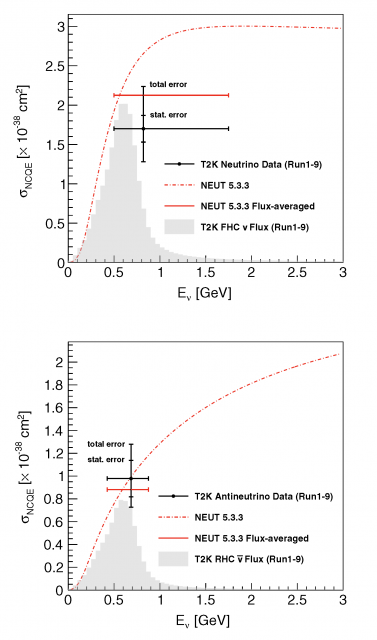
Measurement of the muon neutrino charged-current cross sections on water, hydrocarbon and iron, and their ratios, with the T2K on-axis detectors
σ^{H2O}_{CC}=(0.840±0.010(stat.)+0.10−0.08(syst.))×10−38cm2/nucleon, σ^{CH}_{CC}=(0.817±0.007(stat.)+0.11−0.08(syst.))×10−38cm2/nucleon, and σ^{Fe}_CC=(0.859±0.003(stat.)+0.12−0.10(syst.))×10−38cm2/nucleon,
respectively, for a restricted phase space of induced muons: θμ<45∘ and pμ>0.4 GeV/c in the laboratory frame. The measured cross section ratios are σ^{H2O}_{CC}/σ^{CH}_CC=1.028±0.016(stat.)±0.053(syst.), σ^{Fe}_{CC}/σ^{H2O}_{CC}=1.023±0.012(stat.)±0.058(syst.), and σ^{Fe}_{CC}/σ^{CH}_{CC}=1.049±0.010(stat.)±0.043(syst.). These results, with an unprecedented precision for the measurements of neutrino cross sections on water in the studied energy region, show good agreement with the current neutrino interaction models used in the T2K oscillation analyses.
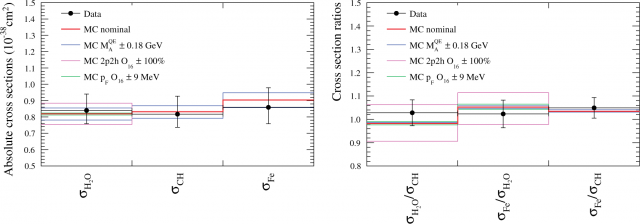
Search for neutral-current induced single photon production at the ND280 near detector in T2K
DOI: https://dx.doi.org/10.1088/1361-6471/ab227d
ArXiv: https://arxiv.org/abs/1902.03848
Physics World: https://physicsworld.com/a/t2k-searches-for-single-gamma-rays-from-neutrino-interactions
